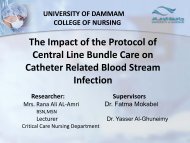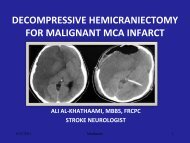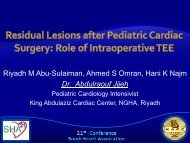Approach for small aortic root - RM Solutions
Approach for small aortic root - RM Solutions
Approach for small aortic root - RM Solutions
You also want an ePaper? Increase the reach of your titles
YUMPU automatically turns print PDFs into web optimized ePapers that Google loves.
Hani K. Najm MD<br />
King Abdulaziz Cardiac Centre<br />
Riyadh.
Patient-Prosthesis Mismatch:<br />
Residual gradient<br />
Progressive LV dysfunction<br />
Hemolysis.<br />
Bulky bioprostheses /<strong>small</strong> annulus
Effective orifice area index=<br />
Effective orifice area/BSA(Sq.m)<br />
2.0 0r above is normal<br />
0.67 Severe stenosis<br />
Rahimtoola first described 1978<br />
Pibarot and Dumensnil (1998) defined PPM to be effective<br />
orifice area indexed to BSA of 0.85m 2 /m 2 or less
Root replacement<br />
Homografts<br />
Stentless xenografts<br />
Ross operation alone.<br />
Posterior annular enlargement:<br />
Nicks’ technique.<br />
Manouguian technique.<br />
Anterior annular enlargement:<br />
Rastan-Konno operation.<br />
Konno-Ross operation.<br />
Apico-<strong>aortic</strong> conduit.
It is usually taken by the surgeon operating and<br />
on a feeling that the annular size is <strong>small</strong>er than<br />
required <strong>for</strong> that patient depending on :<br />
Pt age<br />
Comorbid conditions<br />
Anatomy of the <strong>aortic</strong> <strong>root</strong><br />
Surgeon’s judgment<br />
Surgeon’s com<strong>for</strong>t level
Nicks technique<br />
Manouguian technique
Aortotomy extended towards<br />
<strong>aortic</strong> annulus related to the<br />
middle of non-coronary cusp<br />
(NCC).<br />
Incision extended across <strong>aortic</strong><br />
annulus and then across mitral<br />
annulus and into the body of<br />
anterior mitral leaflet (AML).<br />
Aortic annulus opens up in the<br />
<strong>for</strong>m of inverted-V with apex<br />
towards AML.
A v-shaped dacron patch<br />
sutured to the edges of<br />
this incision thus enlarges<br />
<strong>aortic</strong> annulus by 2-3 cm.<br />
Interrupted sutures <strong>for</strong><br />
holding prosthesis passed<br />
circumferentially into<br />
<strong>aortic</strong> annulus except<br />
posteriorly where they are<br />
passed through dacron<br />
patch.
Oblique aortotomy extended towards and across<br />
the commissure between LCC and NCC, thus<br />
dividing the annulus.<br />
Incision extended vertically across the triangular<br />
area between two cusps and thereafter into the<br />
<strong>aortic</strong>-mitral fibrous continuity.
Tear-drop shaped Dacron patch is sutured to the<br />
defect to enlarge the posterior annulus.<br />
Valve sutures are brought from outside the patch<br />
at annular level.<br />
Rest of the patch is used to close aortotomy<br />
incision.
Challenging problem
Required more commonly in children.<br />
Indicated when <strong>aortic</strong> annulus and left<br />
ventricular outflow tract are narrow (Congenital<br />
tunnel stenosis).<br />
Longitudinal anterior aortotomy is extended across<br />
anterior annulus and inter-ventricular septum to<br />
open LVOT.<br />
Incision extended to open RV outflow tract.
Dacron/ bovine pricardial patch is used to enlarge<br />
LVOT and prosthesis is inserted.<br />
Second dacron/bovine pericardial patch is used<br />
to close right ventricular outflow incision.
For patients suitable <strong>for</strong> autograft <strong>aortic</strong> valve<br />
replacement who have tunnel-type LVOT.<br />
Rastan-Konno approach is used to expose and<br />
open LVOT.<br />
Pulmonary autogaft is harvested and used as in<br />
classical Ross procedure.
‣ LVOT tunnel like<br />
‣ Aortic regurgitation after balloon angioplasty in<br />
neonatal age with <strong>small</strong> annulus<br />
‣ Mismatch in the <strong>aortic</strong> and pulmonary size.<br />
‣ Pulmonary autograft ideal <strong>for</strong>:<br />
per<strong>for</strong>mance, growth potential, avoidance of<br />
anticoagulation.
Combine the Rastan-Konno<br />
and a pulmonary Autograft<br />
like in the Ross procedure.
Ross/Konno procedure
Apico-<strong>aortic</strong> valved conduit
It is an alternative when there is:<br />
• Severe left ventricular<br />
hypertrophy.<br />
• Diminutive left ventricular<br />
size.<br />
• Diffuse thickness of the IVS.<br />
• Multiple <strong>aortic</strong> valve<br />
replacements with <strong>small</strong><br />
<strong>aortic</strong> <strong>root</strong>.
Apico-<strong>aortic</strong> conduit
1989 – 2006<br />
712 with <strong>small</strong> <strong>aortic</strong> <strong>root</strong>s<br />
540 AVR with
Aortic cross clamp was 9.9 min longer in<br />
AVR+ARE<br />
No difference in reopening, stroke or mortality<br />
Post op<br />
Lower gradient<br />
Larger IOA<br />
Lower PPM<br />
No difference in survival
2004-2006<br />
11 women aged >70y<br />
AVR using 17 mm Regent st. Jude prosthesis<br />
Avg BSA 1.33
Small <strong>aortic</strong> <strong>root</strong>s still poses a difficult problem<br />
to the surgeon<br />
There is no clear objective data to suggest the<br />
exact indication <strong>for</strong> ARE<br />
The decision to enlarge the <strong>root</strong> is dependent on<br />
the surgeon evaluation and experience<br />
Presence of PPM may increase gradients and<br />
reduce IEO but does not affect survival
In Infants<br />
Small <strong>root</strong> with no SAS,<br />
Small <strong>root</strong> with SAS<br />
In Children<br />
Small <strong>root</strong> with no SAS,<br />
Small <strong>root</strong> with SAS<br />
In Adults<br />
Small <strong>root</strong>, large BSA<br />
Small <strong>root</strong>, <strong>small</strong> BSA (

















